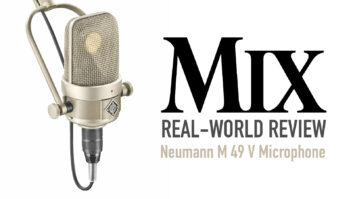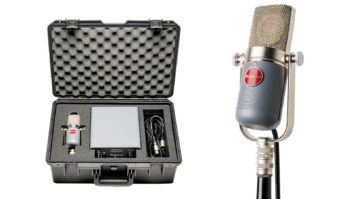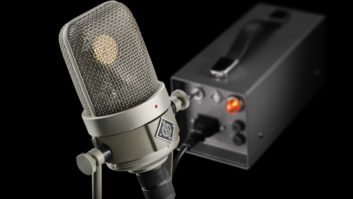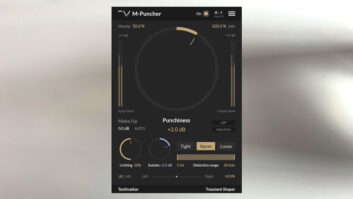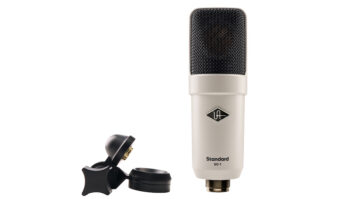Founded by Georg Neumann and named after the city in Germany that is home to Neumann’s manufacturing facility, the Gefell microphone company has lineage that reaches back to the birth of the condenser microphone. However — arguably because Gefell was swallowed by the Eastern bloc in the years after World War II — the company still does not share the popularity and brand recognition enjoyed by its parent company in the West.
Microtech Gefell, as the company is now called, offers a full line of condenser mics and some groundbreaking efforts such as the KEM970 line array microphone. Its latest release, the M 300 miniature cardioid condenser, has the same quality look and feel as the rest of the product line. I tested a matched stereo pair of M 300s, which ship in an attractive padded wooden box and come with a stereo bar and mic clips.
THE M 300 REVEALED
The M 300 oozes quality right out of the box; the dark bronze finish on the mic and other parts is tough and handsome. All parts fit together with little play. In fact, when I first assembled the stereo bar, I thought there was a mismatch between the threads. In just a half-turn, I met with enough resistance that my cross-thread warning radar came to full attention. Once I got the rig together with a bit more muscle, it was easy to take apart and reassemble with much less effort. The mics fit into the clip in what looks like a Teflon ring that is machined tightly to the mic’s diameter. This instilled a sense of confidence, knowing that over time, they would not loosen.
In a few tests in different positions, I found that the stereo bar could have used one more articulation to make it easier to use vertically with a boom stand. The “T” bar mounts directly to the stand with no front/back swivel, making it impossible to use with a traditional boom stand unless you’re using it to position the mics directly downward, such as over a drum kit. You could use it on a stand without a boom, but then you are at the mercy of the stand’s vertical height. When I used it to record an acoustic guitar, for instance, I had to forego using the stereo bar just for this reason; I couldn’t get the mics low enough to use with the seated player. I did try to turn the whole rig upside down, but once again, I was at the mercy of my boom and couldn’t get the mics high enough to work for me. One very nice thing is that Gefell has included a spacer for one of the mics used on the boom so when you use them in X/Y, the capsules come together perfectly spaced, one over the other. When I configured a pair of room mics on a high, boomless vertical stand or drum overheads, I had no problems.
It’s worth noting that the capsules are made of ceramic. This provides greater stability and a more consistent performance when the mics are subjected to heat, such as under stage and studio lights.
ABLE PLAYERS
Each mic comes with an individual color frequency response chart (tested at 0 degrees and 180 degrees), with the serial number, sensitivity rating (both at 11.9 mV/Pa = 0 dB) and date of test, all signed by the technician. The mics tested were spot-on in the on-axis test, with the most differences revealed in the off-axis test. As advertised, there is a decided boost in the high end that starts rising at 2k, tops out at 10k (+4 dB) and then falls off drastically starting at 15k.
I first heard the M 300s as a spaced pair of overheads on a drum kit. This is a kit I’ve had much experience recording with and have used a number of different mics to do the job. My first impression was that the M 300s were too bright. I’ve used other mics with similar characteristics, and I break them into two categories: mics that are harshly bright and those that are smoothly bright. The Gefells fall into the latter category — the better of the two. However, this is still too bright for my taste. If this recording was going to live on analog tape, I would let the extra boost ride, but on the Otari RADAR, the way it sounds today is exactly the way it will sound tomorrow and I wouldn’t want this much high-end boost then, either. Next, I heard them as room mics on the same kit. The mics’ natural high-end boost worked much better in this application, tastefully bringing out the room in the mix.
I absolutely loved the M 300s for recording acoustic guitar. They perfectly brought out the string and pick sound, making it easy to fit into the mix. They also worked very well when used to record stereo percussion, perfectly articulating a variety of toys, even at high SPL. (They will take a whopping 147 dB.)
FALLING FOR GEFELL?
For certain applications, I’m a big fan of mics with extended top end. However, in my experience, these mics can sometimes be too bright in certain situations, and the M 300 is no exception. It seemed to me that over a drum kit, the top end was too bright. The top is smooth, but a bit over the top, in my estimation.
I had the same experience when they were used to record a small orchestral ensemble. However, when used as room mics while recording drums or for percussion, the M 300s excelled. Also, when used to record acoustic guitar, they were stellar.
All that said, at this price ($1,200 a pair), these mics are well worth a listen. No mic is a can-do mic for every situation, and having some specialists in the locker can take the average recording to the next level.
Dist. in North America by C-TEC, 604/942-1001, www.cabletek.ca, www.gefell-mics.com.
Kevin Becka is Mix’s technical editor.
